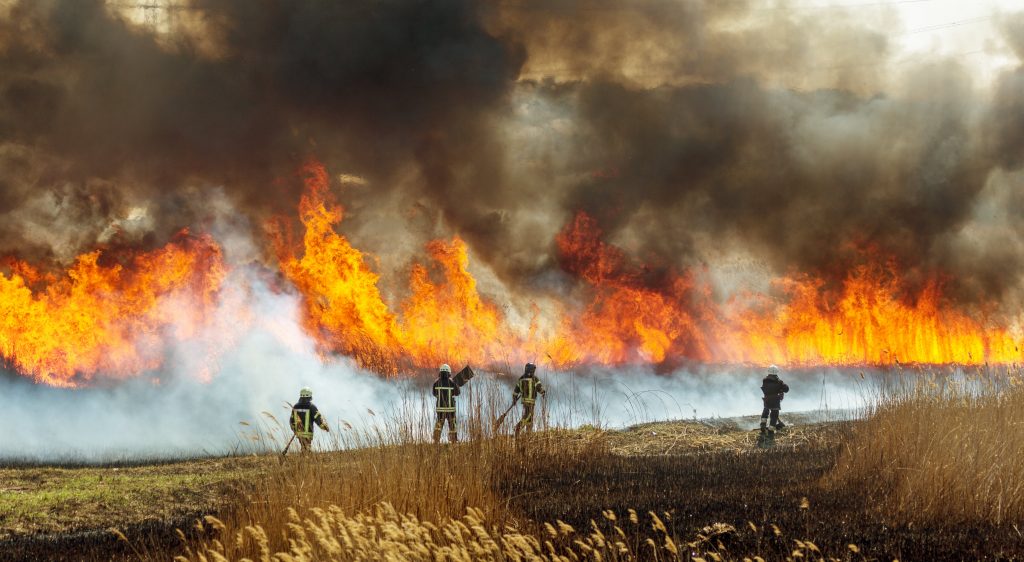“The latest data on forest fires confirms what we’ve long feared: Forest fires are becoming more widespread, burning nearly twice as much tree cover today as they did 20 years ago.” – World Resources Institute, 2023. Wildfires are becoming more frequent, more intense, and more destructive around the world.
According to the National Interagency Fire Center, the U.S. experienced 58,950 wildfires in 2020, burning over 10.1 million acres of land. This was the highest annual acreage burned since 2015, and the second-highest in the past decade.
According to CBC, The 2023 wildfire season is now British Columbia’s most destructive on record only in mid-July.

The impacts of wildfires are not limited to the U.S. In 2020, Australia faced its worst bushfire season on record, with over 46 million acres burned, 34 lives lost, and over 3,000 homes destroyed. In Europe, wildfires burned over 1.4 million acres in 2020, mainly in France, Spain, Portugal, Greece and Turkey. In Asia, wildfires raged across Siberia, Indonesia, China, and India, affecting millions of people and ecosystems.
The main drivers of the increasing wildfire risk are climate change and human activities. It becomes hotter and drier conditions that make vegetation more flammable and fire seasons longer.
What can be done about it?
With wildfires becoming an increasingly prevalent threat, the insurance industry is compelled to contemplate the implications seriously. But how can we turn theory into actionable tactics?
Incorporating wildfire risk into underwriting policies and pricing models. Insurance companies should spearhead a meticulous overhaul of underwriting policies and pricing models to reflect the escalating and forecasted wildfire risk. It’s crucial to incorporate the most advanced data and tools for a comprehensive evaluation of wildfire hazards, exposure, and vulnerability. Moreover, we must appreciate the role of climate change in shaping future wildfire scenarios. This understanding warrants a reassessment of premiums, aligning them more realistically with the transformed risk profile.
Promoting wildfire mitigation practices among customers. The role of education in managing wildfire risks cannot be overstated. Insurance firms should serve as information hubs, offering their customers in-depth knowledge about creating and keeping defensible spaces. Strategic advice could include using fire-resistant materials in construction, installing smoke alarms or sprinklers, and devising emergency response plans. Beyond education, custom policy incentives can encourage the adoption of these measures. Reducing premiums for clients who implement recommended measures or participate in community-based fire prevention programs can be an effective strategy. Highlighting the human factor in wildfire genesis is crucial. Educate customers about safer behaviors in wildfire-prone areas, such as adherence to local fire safety regulations and timely reporting of uncontrolled fires. This foundational awareness is a potent first line of defense in wildfire prevention.

Fostering inter-sector collaboration for wildfire risk reduction. Wildfire risk management is a shared responsibility. Instead of operating as isolated entities, insurance companies can leverage the collective power of stakeholders. Partnering with local government bodies, fire departments, community groups, and other insurers can accelerate risk reduction initiatives like fuel management. In summary, as wildfires continue to become potent threats, proactivity must underscore the strategies of insurance companies. By rewriting the rules of underwriting models, educating customers, and promoting cross-industry collaboration, we can indeed make a significant stride in mitigating future wildfire risks. Inter-sector collaboration often occurs in Florida. Read our “Property Insights in the Hurricane Seasons” article to find out how the State of Florida works with insurance companies to help mitigate risk.
Strengthening Claims Management Systems. As the frequency and intensity of wildfires grow, it’s imperative for insurance companies to brace for a parallel uptick in claims. Upgrading and stress-testing claims management systems in preparation for this probable surge can lead to more efficient responses when disasters strike. Companies can employ advanced AI technologies that streamline claims assessment or introduce fast-track processing for disaster-related claims. Adopting digital solutions for policyholders to report losses can provide rapid, real-time loss data helping insurers to respond more swiftly. Also, regular staff training on handling catastrophic claims can ensure the claim team is well-prepared to empathetically and effectively address policyholders’ grievances during distressing times.
Preparing for future wildfire seasons calls for a multi-faceted approach: updating underwriting and pricing models, engaging policyholders in wildfire mitigation practices, bolstering partnerships with relevant stakeholders, and augmenting claims management systems. Such an approach can serve to fortify both insurers and their clients in the face of increasing wildfire risks.
The modern approach
In the increasingly hazardous landscape of wildfires, data is a vital tool that can empower insurers to devise more effective risk management strategies. Tensorflight, with its AI-enhanced systems, integrates diverse forms of imagery data—satellite, aerial, and street view—to yield detailed data on properties spread across the globe. Here’s how Tensorflight can help insurers navigate the wildfire threat landscape.
Accurate replacement cost estimation using AI. One of our key offerings lies in providing accurate AI-powered replacement cost estimates. By factoring in diverse property attributes, like size, shape, materials, and location, insurers can ensure their clients are accordingly covered and adequately compensated when wildfires cause damage.
Mapping defensible space around properties. Our technology enables the calculation of a property’s ‘defensible space’—the buffer that should be maintained clear of flammable material as per the National Fire Protection Association recommendations. With this data accessible directly or through API, insurers can guide policyholders to strengthen their first line of defense against wildfires.
Year-built data for insights into property resilience. Tensorflight also sources year-built data from tax records. This information is crucial to understanding the building codes in place during construction, providing insights into a building’s resilience to wildfires. It equips underwriters with the knowledge to apply more effective risk management strategies.
Additionally, Tensorflight’s functionality could be extended to enhance claims management systems. Leveraging AI can streamline claim processing, especially during a surge in wildfire-related claims. The data procured can be deployed to educate policyholders on loss prevention and motivate them to implement measures through incentives.

Summary
As our understanding and anticipation of wildfire risks evolve, insurers have the opportunity to adjust their strategies—responding proactively, rather than reactively, to these challenges. Updating underwriting policies and pricing models, incentivizing customers to adopt wildfire mitigation practices, fostering collaborations with local communities and authorities, upgrading claims management systems, and leveraging modern tools like Tensorflight, are all critical steps in this journey.

